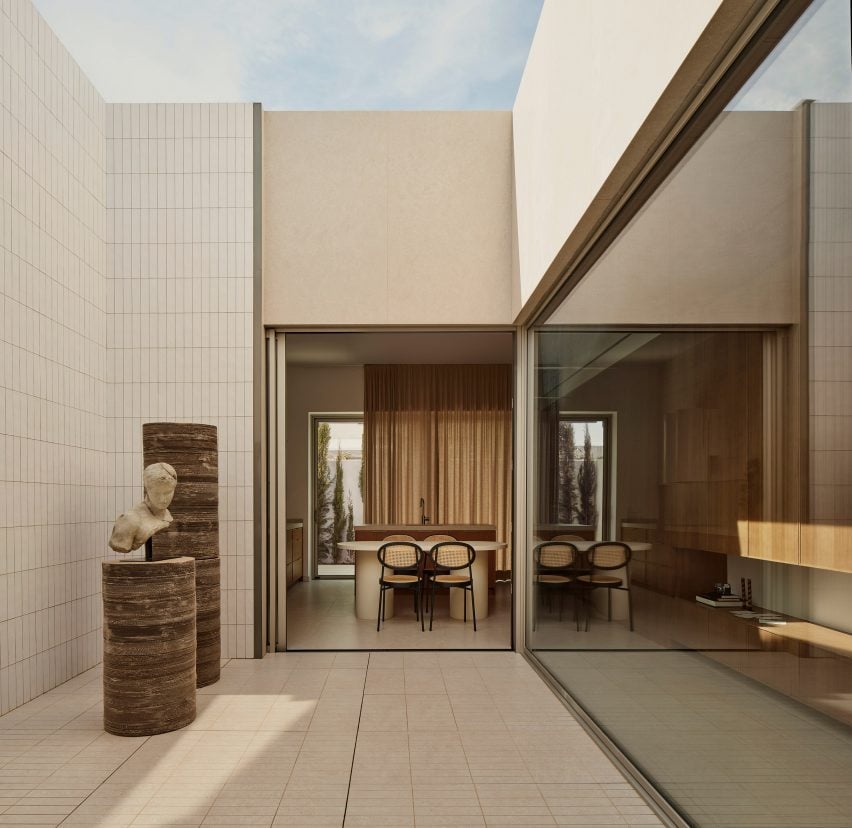
Casa Gesso is a "habitable blank canvas" for reflecting on feminist art
Living spaces are arranged around a central courtyard at this house in Valencia, Spain, which local studio Viruta Lab has designed to celebrate the legacy of influential feminist artist Ángela García Codoñer.
Casa Gesso aims to establish a dialogue between contemporary architecture and some of the pioneering work created by the artist in the 1970s, deconstructing how women were traditionally portrayed in Spanish society.

Viruta Lab founders David Puerta and María Daroz are fans of García Codoñer, who is best known for her collages, screen prints and acrylic paintings featuring stylised depictions of the female form.
García Codoñer was also Puerta's professor at the Valencia School of Architecture and later his mentor at the university's Artistic Heritage Fund.

He explained that the artist's approach to colour and form informed the material palette and minimalist aesthetic of the house, which he described as a "habitable blank canvas" for reflecting on her work.
"In essence, it is a home that allows one to inhabit the ideas of Ángela García Codoñer and demonstrates that residential spaces can also be conceived for reflection and questioning established norms," the duo said.
The 145-square-metre property in the suburb of Picanya is composed of two volumes that reflect the different heights of the neighbouring buildings.

The main living spaces are contained within a one-and-a-half-storey high structure that adjoins a two-storey high block housing the bedrooms and bathrooms.
The building's facades are clad with vertical bone-white porcelain tiles chosen to evoke the traditional washhouses that once housed local artists' studios.

A courtyard at the centre of the house provides natural light and ventilation to the living room and kitchen-dining room located on either side.
This space is clad with the same porcelain tiles as the facades to create a sense of continuity between interior and exterior, while a section of the adjacent hallway floor is finished with slimline tiles to match the courtyard's surface.

"The day area sequence is composed of three completely pure architectural prisms, geometrically and visually uninterrupted, with the second being a void positioned between two solids, emphasising views through transparency," Puerta told Dezeen.
"These volumes are designed as perfect spaces of calm and contemplation, suitable for working or exhibiting artworks like an exhibition hall, thus projected with half-height ceilings."
Each of the living spaces in Casa Gesso was inspired by a particular series in García Codoñer's oeuvre, with furniture, fabrics and artificial lighting chosen to reinforce their different themes.
"Within the design's rich details, the effect of calm and unity allows Ángela García Codoñer's work to dominate the space, becoming the architectural protagonist, supported by changing elements like light that make their nuances vibrate in diverse ways," said Daroz.

The living room at the home's entrance houses a 1979 work from her Labores series exploring traditionally female handicrafts, which Viruta Lab referenced through the inclusion of rugs, upholstery elements and decorative details that evoke cross-stitch.
A painting from the 1973 Morfologías series, in which García Codoñer deconstructed the way women are portrayed in Spanish society, features in the kitchen. Here, rounded forms recall the sinuous shapes found in the paintings, while a female bust provides a focal point in the courtyard.
A wall that extends the full length of the house and separates its two programmatic volumes is lined with storage that incorporates a door leading to a concealed staircase connecting the two floors.

The main bedroom houses a 1974 collage from the Misses series, which denounced the objectification of women in beauty pageants. The work is paired with a tweed headboard alluding to the meticulous "construction" of the female image, as well as the artist's collage work.
A pared-back material palette creates a sense of warmth and neutrality throughout the interior. Large-format porcelain tiles used for the floors are complemented by the natural tone of the stained-oak cabinetry, while upholstery introduces a softer element to the scheme.

The architects told Dezeen that the way Casa Gesso is organised and decorated results in spaces that are suitable for observing and experiencing García Codoñer's work, without explicitly feeling like an exhibition.
"Architecture, with its constraints, was designed to perfectly respond to the initial concept, and together with materiality, they cohesively created this universe of reflection," Daroz said.
"Spaces possess specific functions and are created for activities but we attempted to blur the rigid lines limiting them, enabling them to serve purposes beyond their initial design."

Daroz and Puerta founded Viruta Lab in 2020 as a reflection of their shared artistic and architectural passions. The studio aims to deliver organic, warm and timeless spaces that balance function with emotion.
Previous projects by Viruta Lab include the renovation of a former fisherman's house in Valencia's El Cabanyal neighbourhood, featuring chequerboard tiles that reference the building's nautical heritage.
The photography is by David Zarzoso.